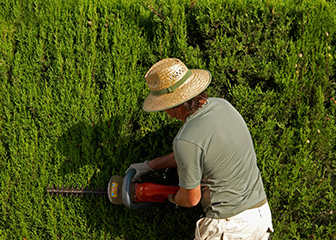
Grounds maintenance workers mow, edge, and fertilize lawns.
Grounds maintenance workers provide a pleasant outdoor environment by ensuring that the grounds of houses, businesses, and parks are attractive, orderly, and healthy.
Duties
Grounds maintenance workers typically do the following:
- Mow, edge, and fertilize lawns
- Weed and mulch landscapes
- Trim hedges, shrubs, and small trees
- Remove dead, damaged, or unwanted trees
- Plant flowers, trees, and shrubs
- Water lawns, landscapes, and gardens
Grounds maintenance workers do a variety of tasks to achieve a pleasant and functional outdoor environment. They also care for indoor gardens and plantings in commercial and public facilities, such as malls, hotels, and botanical gardens.
The following are types of grounds maintenance workers:
Landscaping workers create new outdoor spaces or upgrade existing ones by planting trees, flowers, and shrubs. They also trim, fertilize, mulch, and water plants. Some grade and install lawns or construct hardscapes such as walkways, patios, and decks. Others help install lighting or sprinkler systems. Landscaping workers work in a variety of residential and commercial settings, such as homes, apartment buildings, office buildings, shopping malls, and hotels and motels.
Groundskeeping workers, also called groundskeepers, maintain existing grounds. They care for plants and trees, rake and mulch leaves, and clear snow from walkways. They work on athletic fields, golf courses, cemeteries, university campuses, and parks, as well as in many of the same settings as landscaping workers. They also see to the proper upkeep and repair of sidewalks, parking lots, groundskeeping equipment, fountains, fences, planters, and benches.
Groundskeeping workers who care for athletic fields keep natural and artificial turf in top condition, mark out boundaries, and paint turf with team logos and names before events. They mow, water, fertilize, and aerate the fields regularly. They must make sure that the underlying soil on fields with natural turf has the required composition to allow proper drainage and to support the grasses used on the field. In sports venues, they vacuum and disinfect synthetic turf after its use to prevent the growth of harmful bacteria, and they remove the turf and replace the cushioning pad periodically.
Groundskeepers in parks and recreation facilities care for lawns, trees, and shrubs; maintain playgrounds; clean buildings; and keep parking lots, picnic areas, and other public spaces free of litter. They also may erect and dismantle snow fences, and maintain swimming pools. These workers inspect buildings and equipment, make needed repairs, and keep everything freshly painted.
Some groundskeepers specialize in caring for cemeteries and memorial gardens. They dig graves to specified depths, generally using a backhoe. They mow grass regularly, apply fertilizers and other chemicals, prune shrubs and trees, plant flowers, and remove debris from graves.
Greenskeepers maintain golf courses. Their work is similar to that of groundskeepers, but they also periodically relocate holes on putting greens and maintain benches and tee markers along the course. In addition, greenskeepers keep canopies, benches, and tee markers repaired and freshly painted.
Pesticide handlers, sprayers, and applicators apply herbicides, fungicides, or insecticides on plants or the soil to prevent or control weeds, insects, and diseases. Those who work for chemical lawn or tree service firms are more specialized, inspecting lawns for problems and applying fertilizers, pesticides, and other chemicals to stimulate growth and prevent or control weeds, diseases, or insect infestations.
Tree trimmers and pruners, also called arborists, cut away dead or excess branches from trees or shrubs to clear utility lines, roads, and sidewalks. Although many workers strive to improve the appearance and health of trees and plants, some specialize in diagnosing and treating tree diseases. Others specialize in pruning, trimming, and shaping ornamental trees and shrubs. Tree trimmers and pruners use chainsaws, chippers, and stump grinders while on the job. When trimming near power lines, they usually work on truck-mounted lifts and use power pruners.









